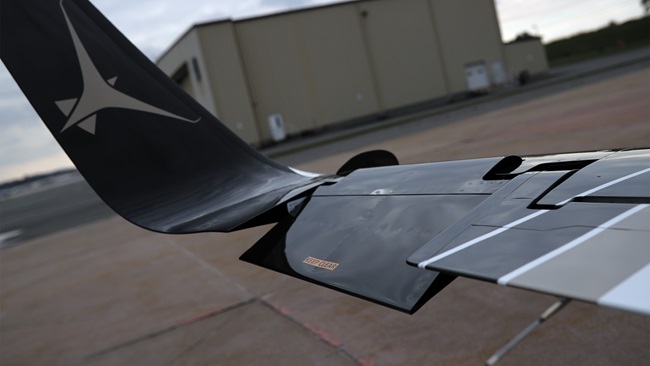Tamarack Aerospace expands, cites demand
Tamarack Aerospace announced that recent expansion has tripled the company’s office space in Sandpoint, Idaho, and acquired a third hangar, part of a plan to grow to meet demand for active winglet installations as the firm rebounds from a “tough year” that included a voluntary bankruptcy petition.
The coronavirus pandemic has had double-edged effects on Tamarack, driving new orders on the one hand while delaying the firm’s bid to put Chapter 11 bankruptcy behind it on the other. President Jacob Klinginsmith, in a telephone interview, said that the last major issue in the bankruptcy case has been resolved: The company’s insurance provider, he said, has agreed (following a long delay and various extensions in the case) to pay claims by aircraft owners arising from the May 2019 grounding of 97 Cessna Citation jets with Tamarack’s active load-alleviation system (ATLAS) winglets installed.
“We’re excited to finalize that” bankruptcy case, Klinginsmith said, noting that the company expects to conclude the court proceedings with all of its creditors, shareholders, and customers “intact, which is unusual … Ideally, we’d be out in October, but it’s really out of our hands.”
Federal court records indicate the case is indeed nearing resolution. Tamarack’s plan to reorganize and emerge from Chapter 11 had been approved by the time it briefed the media at the National Business Aviation Association convention in October 2019, at which point the company hoped to have the case concluded by the end of the year. The pandemic has delayed that progress, Klinginsmith said. “I’m looking forward to having it behind us, but we’re not letting it slow us down.”
The company announced in a recent news release that the office space in Sandpoint has been tripled and the firm is acquiring a third hangar, part of a recent expansion to accommodate demand for ATLAS installations on Cessna Citations, and for versions yet to be approved for other aircraft models. The company has recently hired new sales staff, and has engineering jobs posted that Klinginsmith said will be tasked with expanding the list of 30 patents, and eight Citation variants for which supplemental type certificates have already been granted. Klinginsmith said expanding to other aircraft models has always been the plan, though he declined to specify which aircraft might be next in line to get the ATLAS winglets, which dramatically reduce fuel consumption and increase useful load.
“Last year, we scaled back across the company,” Klinginsmith said. The total staff was trimmed from 32 to 19 during the grounding and bankruptcy proceedings, but has since rebounded: “Today, we’re sitting right at 27 people, companywide.”
Tamarack’s recent expansion extends to Europe, where a facility in the United Kingdom opened in July, according to the news release. The London-based operation has been running seven days a week to fill orders and secure new sales.
Klinginsmith said the firm passed a milestone over the winter, with more than 100 ATLAS installations completed. That still leaves a large market to tap, even before additional STC approvals are secured to install ATLAS in other aircraft models: There are nearly 2,000 Citations in active service that are eligible for ATLAS, Klinginsmith said, and orders have been coming in on both continents where Tamarack has facilities, as well as from South America.
By driving demand for private air travel, the pandemic has boosted Tamarack’s bottom line.
“A lot of planes are trading hands, is what we’ve seen,” Klinginsmith said, noting that both current and prospective owners are looking to upgrade the capabilities of these aircraft. Installing ATLAS winglets can increase the maximum zero-fuel payload of a Citation CJ2 by 800 pounds, Klinginsmith said, in addition to saving fuel. Klinginsmith noted that ATLAS increases aircraft utility while reducing cost, and that has also been a boon for customers: “Our product has really changed their life for the better.”
Klinginsmith said utilization of existing aircraft has been high even as commercial aviation has suffered mightily, and in large part because of that. Cessna Citations have proved to be popular alternatives to airline travel, particularly with the health concerns involved in sharing a large aircraft with many people, as well as the reduction in routes served by airlines.
Despite the frustration of having to speak about bankruptcy in the present tense, Klinginsmith said the company is proud to have achieved its goals of protecting customers, creditors, and shareholders alike from financial loss. Klinginsmith said only about 10 percent of firms that file for Chapter 11 protection have such a reorganization approved. “We’re really proud of having gotten to that point.”
The irony that a global health crisis has boosted sales, created jobs, and expanded the firm’s prospects is not lost on the former chief engineer.
“We all know this is a strange time,” Klinginsmith said.




